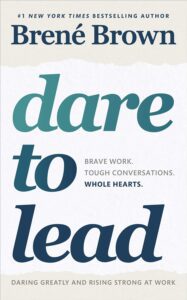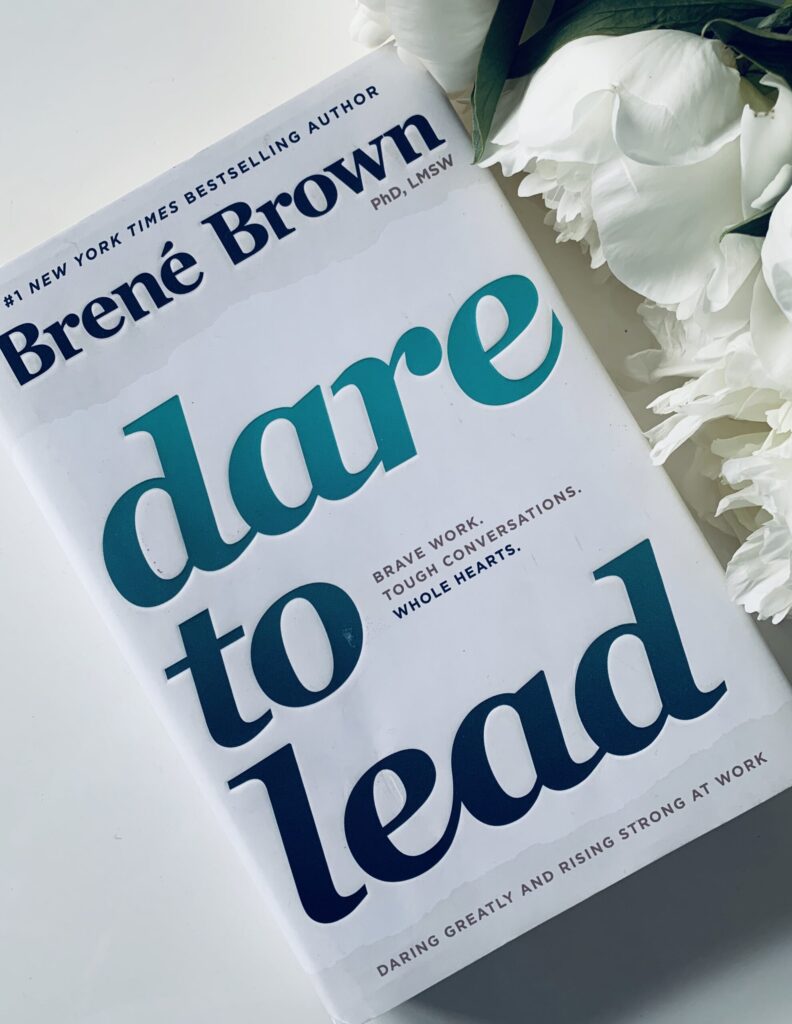 Dare to Lead
Dare to Lead
Brave Work. Tough Conversations. Whole Hearts.
Brené Brown
Random House; First Edition (9 Oct. 2018)
About Brené Brown
Dr. Brené Brown is a research professor at the University of Houston, where she holds the Huffington Foundation Endowed Chair at the Graduate College of Social Work. She also holds the position of visiting professor in management at the University of Texas at Austin McCombs School of Business. Brené has spent the past two decades studying courage, vulnerability, shame, and empathy. She is the author of six #1 New York Times best sellers and is the host of two award-winning Spotify podcasts, Unlocking Us and Dare to Lead. Brené’s books have been translated into more than 30 languages, and her titles include Atlas of the Heart, Dare to Lead, Braving the Wilderness, Rising Strong, Daring Greatly, and The Gifts of Imperfection. With Tarana Burke, she co-edited the best-selling anthology You Are Your Best Thing: Vulnerability, Shame Resilience, and the Black Experience. Brené’s TED talk on the Power of Vulnerability is one of the top five most-viewed TED talks in the world, with over 50 million views. Brené is the first researcher to have a filmed lecture on Netflix, and in March 2022, she launched a new show on HBO Max that focuses on her latest book, Atlas of the Heart.
About The Book:
“At the heart of daring leadership is a deeply human truth that is rarely acknowledged, especially at work: Courage and fear are not mutually exclusive. Most of us feel brave and afraid at the exact same time. We feel vulnerable. Sometimes all day long. During those “in the arena” moments that Roosevelt described, when we’re pulled between our fear and our call to courage, we need shared language, skills, tools, and daily practices that can support us through the rumble.
The word rumble has become more than just a weird West Side Story way to say, “Let’s have a real conversation, even if it’s tough.” It’s become a serious intention and a behavioral cue or reminder.
A rumble is a discussion, conversation, or meeting defined by a commitment to lean into vulnerability, to stay curious and generous, to stick with the messy middle of problem identification and solving, to take a break and circle back when necessary, to be fearless in owning our parts, and, as psychologist Harriet Lerner teaches, to listen with the same passion with which we want to be heard. More than anything else, when someone says, “Let’s rumble,” it cues me to show up with an open heart and mind so we can serve the work and each other, not our egos.
Our research led to a very clear, very hopeful finding: Courage is a collection of four skill sets that can be taught, observe, and measured. The four skill sets are:
• Rumbling with Vulnerability
• Living into Our Values
• Braving Trust
• Learning to Rise
The foundational skill of courage-building is the willingness and ability to rumble with vulnerability. Without this core skill, the other three skill sets are impossible to put into practice. Consider this carefully: Our ability to be daring leaders will never be greater than our capacity for vulnerability. Once we start to build vulnerability skills, we can start to develop the other skill sets.
The goal of this book is to give you language and specifics on the tools, practices, and behaviors that are critical for building the muscle memory for living these concepts.”
Meet Brené Brown – the foremost authority on vulnerability, courage, and shame. You might recognize her from her TED Talks—The Power of Vulnerability boasts an impressive 65.5 million views, making it one of the most-watched talks ever, while her second TED Talk – Listening To Shame – isn’t far behind with nearly 20 million views. Trust me, they’re worth a watch.
What’s even more impressive? Brené’s storytelling prowess and her exceptional writing skills. Her books have lingered on my to-read list for ages, so I’ve finally taken the plunge and embarked on my “Brené Brown work exploration”, starting with her phenomenal book, Dare to Lead.
This book is nothing short of brilliant, provoking profound reflection at every turn. Drawing from her extensive research spanning nearly two decades, Brené imparts invaluable lessons on cultivating the inner courage necessary to lead effectively. She equips us with practical tools to navigate emotions, overcome fear, and emerge as bold leaders in an increasingly competitive world.
It’s easily one of the finest leadership books I’ve come across, and I wholeheartedly recommend it to anyone—whether you’re a parent, a teacher, or a business leader – anyone who “takes responsibility for finding the potential in people and processes, and who has the courage to develop that potential.”
I have to give credit where it’s due—Brené and her team have outdone themselves with the Dare to Lead Hub. It’s a treasure trove of resources, including a workbook, videos, and more. Plus, they’ve created a separate Daring Classrooms Hub specifically tailored for educators, providing practical tools to implement Daring Leadership principles in schools. It’s like they’ve handed you the keys to immediate action!
As you can guess, the book is absolutely packed with insights and in these notes I’ll share just a few of my favourite ones. Let’s jump in.
Key Insights
What Is Vulnerability?
“The definition of vulnerability as the emotion that we experience during times of uncertainty, risk, and emotional exposure first emerged in my work two decades ago, and has been validated by every study I’ve done since, including this research on leadership. Vulnerability is not winning or losing. It’s having a courage to show up when you can’t control the outcome.”
Vulnerability is one of the key concepts in Brené Brown’s work. Before delving into the first skill of Daring Leadership—rumbling with vulnerability—she takes us on a journey to clearly define what vulnerability truly means and, perhaps more importantly, what it doesn’t.
I’ll admit, when I first stumbled upon Brené’s TED talk years ago, vulnerability seemed like an elusive concept. But with her definition and the exercises from the read-along Workbook, it all clicked into place. Suddenly, I found myself reflecting deeply.
For instance, it dawned on me that embracing vulnerability is the cornerstone of living authentically. It’s the fertile ground from which creativity, innovation, and progress spring forth. And perhaps most importantly, vulnerability forms the bedrock of any meaningful relationship.
In essence, vulnerability is our superpower. Now, let’s take a quick peek at the tools for rumbling with vulnerability and putting it all into action.
Rumbling With Vulnerability – The Tools
“Leaders must either invest a reasonable amount of time attending to fears and feelings, or squander an unreasonable amount of time trying to manage ineffective and unproductive behavior.
What this means is that we must find the courage to get curious and possibly surface emotions and emotional experiences that people can’t articulate or that might be happening outside their awareness. If we find ourselves addressing the same problematic behaviors over and over, we may need to dig deeper to the thinking and feeling driving those behaviors.”
Such insight! Whether leading a team, a family, or yourself, it’s vital to start by understanding the emotions that drive behaviour. Approach with curiosity, an open mind, and wholeheartedness.
Yes, talking about feelings and fears can be uncomfortable and daunting. Yet, it’s essential for making progress towards our goals and driving positive change.
Now, in the book Brené offers several tools to enhance your ability to rumble with vulnerability. Here are a few:
1. The Square Squad
2. Permission Slips
3. Container-building
4. The time-out
5. BRAVING inventory
Brené’s accompanying workbook delves into each tool extensively—definitely worth exploring and implementing!
Also, I really liked Brené’s rumble starters cheat-sheet. Packed with curiosity-fueled questions, it’s a game-changer for communication skills. It reminds me of the conversation starters in The Explosive Child by Ross Greene—so useful for parents.
P.P.: The rumbling with vulnerability skill strongly resonates with Marshall Rosenberg’s principles of Nonviolent Communication (see our notes for more).
Clear Is Kind. Unclear Is Unkind.
“Feeding people half-truths or bullshit to make them feel better (which is almost always about making ourselves feel more comfortable) is unkind. Not getting clear with a colleague about your expectations because it feels too hard, yet holding them accountable or blaming them for not delivering is unkind. Talking about people rather than to them is unkind. This lesson has so wildly transformed my life that we live by it at home. If Ellen is trying to figure out how to handle a college roommate issue or Charlie needs to talk to a friend about something … clear is kind. Unclear is unkind.”
So much wisdom packed into one simple mantra: Clear is kind, unclear is unkind. Let that sink in.
In any relationship – whether at work or at home – just be kind. Be clear.
The Vulnerability Armory.
“As children we found ways to protect ourselves from vulnerability, from being hurt, diminished, and disappointed.
We put on armor; we used our thoughts, emotions, and behaviors as weapons; and we learned how to make ourselves scarce, even to disappear. Now as adults we realize that to live with courage, purpose, and connection-to be the person who we long to be – we must again be vulnerable. We must take off the armor, put down the weapons, show up, and let ourselves be seen.”
When we encase our hearts in armor, we suffocate courage.
Daring leaders lead with wholeheartedness. In her book, Brené outlines sixteen examples of armored leadership—patterns of behavior that emerged from her research—paired with the daring leadership response to each. It strongly resonates with my own findings on transformational leadership. Dive into the book for more insights.
I appreciate how Brené delves into the origins of our vulnerability armor from childhood—a poignant reminder for parents to employ daring leadership skills within their own homes.
Empathy Skills
“In those bad moments, it’s not our job to make things better. It’s just not. Our job is to connect. It’s to take the perspective of someone else. Empathy is not connecting to an experience, it’s connecting to the emotions that underpin an experience. […]
Empathy is a choice. And it’s a vulnerable choice, because if I were to choose to connect with you through empathy, I would have to connect with something in myself that knows that feeling. In the face of a difficult conversation, when we see that someone’s hurt or in pain, it’s our instinct as human beings to try to make things better. We want to fix, we want to give advice. But empathy isn’t about fixing, it’s the brave choice to be with someone in their darkness—not to race to turn on the light so we feel better.”
I love this profound wisdom. Empathy 101.
Great news is that empathy is learnable – it’s a set of skills everyone can (and must) learn and practice. Here they are:
Empathy Skill #1: To see the world as others see it, or perspective-taking
Empathy Skill #2: To be nonjudgmental
Empathy Skill #3: To understand another person’s feelings
Empathy Skill #4: To communicate your understanding of that person’s feelings
Empathy Skill #5: Mindfulness
The key takeaway? Practice empathy. You’ll stumble, you’ll mess up, but don’t give up—circle back, clean up, and try again.
This will turbocharge your emotional intelligence.
P.S.: These are the very skills Dan Siegel and Tina Payne Bryson delve into in their fantastic parenting books – The Whole Brain Child, No Drama Discipline, and The Yes Brain Child. Essential reads for any parent.
Living Into Our Values
“While courage requires checking our armor and weapons at the arena door, we do not have to enter every tough conversation and difficult rumble completely empty-handed.
The daring leaders we interviewed were never empty-handed in the arena. In addition to rumble skills and tools, they always carried with them clarity of values. This clarity is an essential support, a North Star in times of darkness.
According to the Oxford English Dictionary, values are “principles or standards of behaviour; one’s judgment of what is important in life.” In our work, I simplify the definition: A value is a way of being or believing that we hold most important.
Living into our values means that we do more than profess our values, we practice them. We walk our talk-we are clear about what we believe and hold important, and we take care that our intentions, words, thoughts, and behaviors align with those beliefs.”
Great leaders have clear values that guide their behaviour and their decision making. Values serve as the compass for living and leading with integrity.
So, let me ask you this: What are your top two values? And what three behaviours align with each of these values? Are you truly embodying your values?
If you’re struggling to identify your core values, use Brené’s guidance on her Dare to Lead Hub. Or check out my article on How to Identify Your Core Values and Create a Value Statement for more.
The BRAVING Inventory
“The BRAVING Inventory is first and foremost a rumble tool—a conversation guide to use with colleagues that walks us through the conversation from a place of curiosity, learning, and ultimately trust-building. […]
– Boundaries: You respect my boundaries, and when you’re not clear about what’s okay and not okay, you ask. You’re willing to say no.
– Reliability: You do what you say you’ll do. At work, this means staying aware of your competencies and limitations so you don’t overpromise and are able to deliver on commitments and balance competing priorities.
– Accountability: You own your mistakes, apologize, and make amends.
– Vault: You don’t share information or experiences that are not yours to share. I need to know that my confidences are kept, and that you’re not sharing with me any information about other people that should be confidential.
– Integrity: You choose courage over comfort. You choose what is right over what is fun, fast, or easy. And you choose to practice your values rather than simply professing them.
– Nonjudgment: I can ask for what I need, and you can ask for what you need. We can talk about how we feel without judgment. We can ask each other for help without judgment.
– Generosity: You extend the most generous interpretation possible to the intentions, words, and actions of others.”
This trust-building framework from the Braving Trust chapter is invaluable and applicable across all aspects of life.
As John Maxwell emphasizes in The 21 Irrefutable Laws of Leadership, trust forms the bedrock of effective leadership. While he emphasizes building trust through character development (integrity, authenticity, and discipline), Brené emphasizes “braving trust” by demonstrating behaviours that define trust. And I absolutely love it.
Moreover, Brené highlights the difficulty of trusting others when our own self-trust is lacking—a crucial insight.
So, how do we wield this rumbling tool? Start by assessing your strengths and areas for growth across these seven elements, whether in team dynamics, relationships, or self-trust. Then, pinpoint one or two observable behaviours for each element.
P.S.: I love how Dr Becky incorporated core elements of BRAVING inventory into her work. In Good Inside, she teaches parents how to be sturdy leaders of their families and shows us how these principles work in parenting.
Learning to Rise
“If we don’t have the skills to get back up, we may not risk falling. And if we’re brave enough often enough, we are definitely going to fall. The research participants who have the highest levels of resilience can get back up after a disappointment or a fall, and they are more courageous and tenacious as a result of it. They do that with a process that I call Learning to Rise. It has three parts: the reckoning, the rumble, and the revolution.”
Resilience ranks high among life’s essential skills. We all stumble, we all face obstacles and failures. It’s just part of the journey. The key is to own our failures and approach them with a growth mindset. That’s what Learning to Rise is all about.
Here’s a snapshot of the three steps in this process:
– The reconning – Recognize when you’re emotionally hooked and get curious about it.
– The rumble – Unpack the story you’re telling yourself (what Brené Brown calls the “shitty first draft”).
– The revolution – Summon the courage to move forward and take responsibility for crafting your own “story ending.”
This process aligns closely with Susan David’s concept of Emotional Agility—check out our notes for more insights.
Also, again, check out the Workbook to get the practical tools on how to apply it to day to day life.
Action Steps For You:
1) Commit to becoming a daring leader: Embrace Brene Brown’s concept of daring leadership by examining the contrast between armored and daring leadership models. Reflect on your current leadership style, identify areas for growth, and develop a concrete plan to cultivate specific daring leadership behaviours. You can use the Dare to Lead Workbook for this.
2) Master difficult conversations and rumble with vulnerability: Embrace vulnerability as a strength rather than a weakness, recognizing its power to deepen connections and foster trust. Lean into uncomfortable conversations, utilizing the rumbling tools to engage authentically, listen actively, and work through conflicts constructively.
3) Operationalize trust with BRAVING inventory: Implement BRAVING inventory as a practical framework for building and maintaining trust in your relationships and interactions. Prioritize boundaries, reliability, accountability, vault, integrity, nonjudgment, and generosity in your communication and behaviour. Regularly assess and reinforce these elements within your team or organization (or at home), creating a culture of trust and psychological safety where individuals feel valued, respected, and supported.
Quotes From The Book:
-
“Self-awareness and self-love matter. Who we are is how we lead.”
-
“I define a leader as anyone who takes responsibility for finding the potential in people and processes, and who has the courage to develop that potential.”
-
“We need to trust to be vulnerable, and we need to be vulnerable in order to build trust.”
-
“Integrity is choosing courage over comfort; it’s choosing what’s right over what’s fun, fast, or easy; and it’s practicing your values, not just professing them.”
-
“Just remember, we can’t do our jobs when we own other people’s emotions or take responsibility for them as a way to control the related behaviors, for one simple reason: Other people’s emotions are not our jobs. We can’t both serve people and try to control their feelings.”
-
“When we have the courage to walk into our story and own it, we get to write the ending. And when we don’t own our stories of failure, setbacks, and hurt – they own us.”



